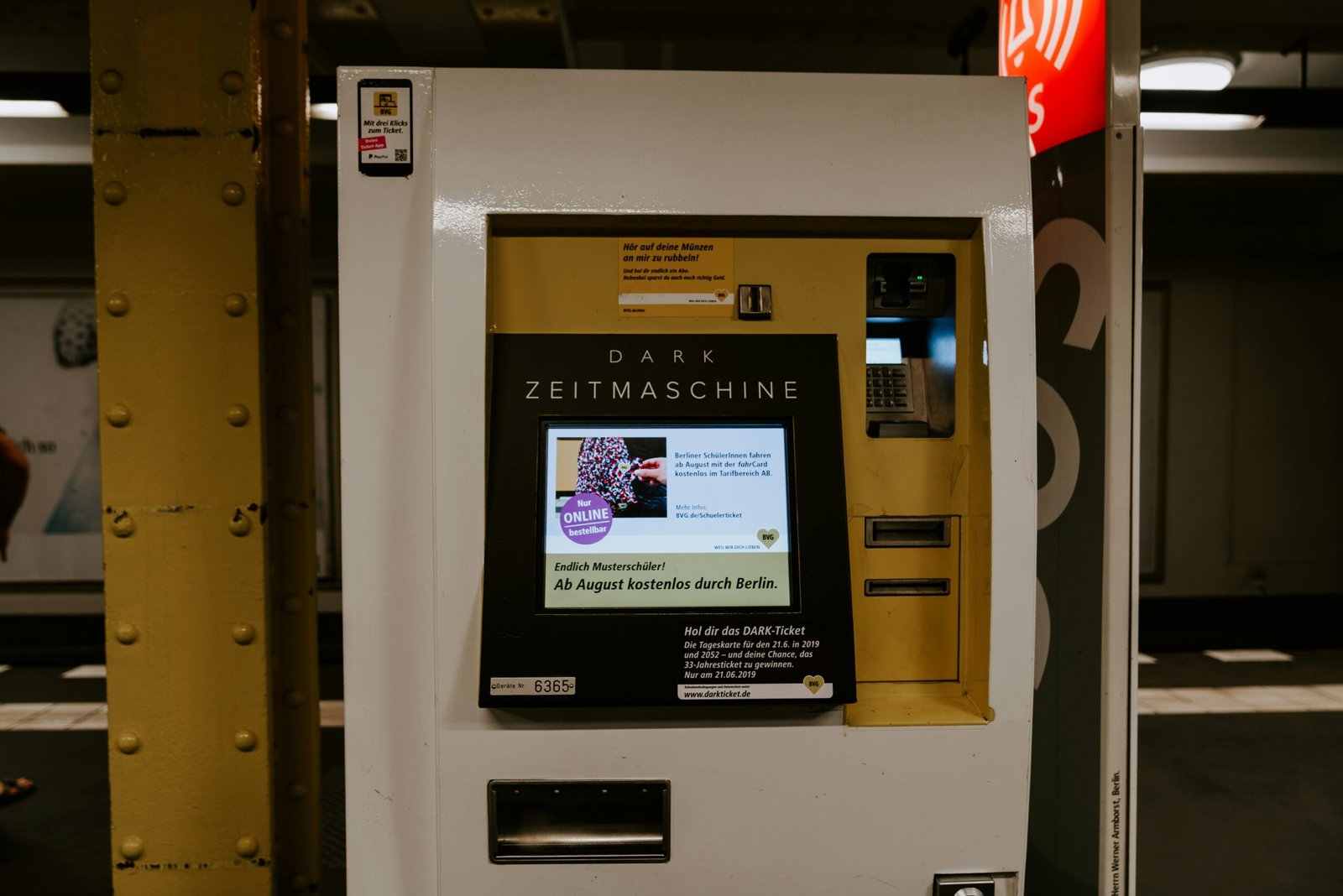Kiosk technology has become an integral component of modern business operations, offering a versatile and efficient medium for various services.
Kiosks are digital terminals or booths that provide information or facilitate transactions without the need for direct human assistance.
These devices have significantly evolved since their inception, transforming from simple information booths to sophisticated, interactive systems.
The history of kiosk technology dates back to the 1970s when the first rudimentary forms were introduced, primarily serving as information providers in public spaces such as airports and shopping malls.
Over the decades, advancements in technology have expanded their functionality and usability.
Today, kiosks are equipped with touchscreens, internet connectivity, and advanced software, making them capable of handling complex tasks ranging from ticketing and check-ins to product browsing and payments.
There are several types of kiosks, each designed to cater to specific business needs. Informational kiosks, for instance, are primarily used to disseminate information, such as directories in shopping malls or schedules in transportation hubs.
These kiosks provide users with easy access to essential information without the need for human interaction.
Self-service kiosks have gained prominence in various industries, including retail, hospitality, and healthcare.
These kiosks empower customers to perform tasks independently, such as placing orders in fast-food restaurants, checking in at hotels, or registering for appointments in clinics.
The efficiency and convenience offered by self-service kiosks enhance customer experience and streamline operations.
Interactive kiosks, on the other hand, offer a more engaging user experience by incorporating features such as touchscreens, video, and audio.
These kiosks are often used in settings that require a higher level of user interaction, such as museums, where they can provide detailed exhibits and educational content.
In summary, kiosk technology has come a long way since its early days, evolving into a multifaceted tool that enhances business operations and customer engagement.
Understanding the different types of kiosks and their functionalities is crucial for businesses looking to implement this technology effectively.
Benefits of Kiosk Technology for Businesses
Kiosk technology has revolutionized the way businesses operate, providing numerous advantages that can significantly impact overall efficiency and customer satisfaction.
One of the primary benefits is the increased efficiency that kiosks bring to daily operations. By automating routine tasks such as check-ins, ticket purchases, and information dissemination, businesses can streamline processes and reduce wait times.
This automation allows employees to focus on more complex and customer-centric tasks, thereby enhancing productivity.
Another substantial advantage is the reduction in labor costs.
Kiosks can perform functions that would otherwise require additional staff, such as processing payments or providing customer service information.
This reduction in manpower not only leads to cost savings but also minimizes the risk of human error, ensuring more accurate and reliable service delivery.
For instance, fast-food chains like McDonald’s have successfully implemented self-service kiosks, allowing customers to place orders without the need for cashier assistance, thereby reducing staffing requirements during peak hours.
Enhanced customer experience is another critical benefit of kiosk technology.
Modern consumers appreciate the convenience and speed that kiosks offer.
With user-friendly interfaces and efficient service, kiosks cater to the growing demand for quick and hassle-free interactions.
Airports, for example, have adopted self-service check-in kiosks, enabling travelers to check in, select seats, and print boarding passes in a matter of minutes, thus improving the overall travel experience.
Moreover, kiosks provide businesses with the ability to gather valuable data.
Through integrated software, businesses can collect information on customer preferences, behavior patterns, and transaction histories.
This data can be leveraged to tailor marketing strategies, improve products and services, and make informed business decisions.
Retail stores, for instance, use kiosks to track purchasing trends and customer feedback, allowing them to better understand market demands and adjust their inventory accordingly.
Real-world examples and case studies further illustrate these benefits.
For example, a case study of a major retail chain showed a 20% increase in sales following the implementation of interactive kiosks.
Another case study of a healthcare provider demonstrated a significant reduction in patient wait times and administrative costs by utilizing self-service check-in kiosks.
These real-world applications highlight the tangible advantages that kiosk technology can offer to various industries.
Types of Kiosk Solutions
Kiosk technology has evolved significantly, offering a range of solutions tailored to various business needs.
Among the most common are self-service kiosks, payment kiosks, informational kiosks, and ticketing kiosks.
Each type serves a distinct purpose and caters to specific industries, enhancing operational efficiency and customer experience.
Self-Service Kiosks
These kiosks are prevalent in the retail and hospitality sectors, providing customers with an efficient way to browse products, place orders, and complete transactions.
Self-service kiosks reduce wait times and free up staff to focus on other tasks, thereby improving overall service quality.
Payment Kiosks
Widely used in financial institutions, retail stores, and transport hubs, payment kiosks facilitate secure and convenient transactions.
They support various payment methods, including cash, credit cards, and mobile payments.
Payment kiosks streamline the payment process, minimize human error, and enhance customer satisfaction by offering quick and reliable service.
Informational Kiosks
These kiosks are designed to provide users with relevant information, such as wayfinding assistance, product details, or event schedules.
Commonly found in shopping malls, airports, and museums, informational kiosks serve as interactive guides, helping visitors navigate spaces and access essential information effortlessly.
Ticketing Kiosks
Used extensively in transportation and entertainment industries, ticketing kiosks allow customers to purchase and print tickets for events, flights, or public transport.
They offer a convenient alternative to traditional ticket counters, reducing queues and wait times while ensuring a smooth and efficient ticketing process.
In addition to these primary types, there are specialized kiosks tailored for niche applications, such as healthcare check-in kiosks, survey kiosks, and digital signage kiosks.
Each kiosk type is designed to address specific business needs, offering versatile and customizable solutions that can be integrated seamlessly into various operational environments.
Understanding the diverse range of kiosk solutions available helps businesses identify the right technology to enhance their services, optimize workflow, and improve customer engagement.
By implementing the appropriate kiosk solution, businesses can achieve greater efficiency and provide a superior user experience.
Key Features to Look for in a Kiosk
When implementing kiosk technology in a business, it is crucial to identify the key features that will ensure both functionality and user satisfaction.
One of the primary aspects to consider is a user-friendly interface.
A well-designed, intuitive interface can significantly enhance user experience, reducing the need for assistance and increasing overall efficiency.
This is especially important in environments with high foot traffic, where ease of use can make a substantial difference.
Security measures are another critical feature that businesses must prioritize.
Kiosks often handle sensitive data, such as payment information and personal details.
Robust security protocols, including data encryption, secure access controls, and regular software updates, are essential to protect this information from cyber threats.
Additionally, physical security features like tamper-proof enclosures and surveillance can help safeguard the hardware itself.
Remote management capabilities are also indispensable for the effective operation of kiosks.
These features allow businesses to monitor and manage their kiosks from a central location, enabling timely updates, troubleshooting, and maintenance without the need for on-site visits.
This not only minimizes downtime but also reduces operational costs and enhances the overall reliability of the kiosk network.
Customizability is another key consideration.
Businesses have unique requirements, and the ability to tailor kiosk solutions to meet these specific needs can lead to better alignment with organizational goals.
This includes the flexibility to integrate various peripherals such as printers, scanners, or payment terminals, as well as the ability to customize software to support specific business processes.
Selecting the right software and hardware components is equally important.
The choice of operating system, compatible applications, and durable hardware can impact the kiosk’s performance and longevity.
Businesses should opt for reliable and scalable solutions that can adapt to evolving needs and technological advancements.
By focusing on these essential features, businesses can ensure the successful implementation of kiosk technology, leading to enhanced operational efficiency and improved customer experiences.
Steps to Implement Kiosk Technology
Implementing kiosk technology in a business setting involves a series of carefully planned steps to ensure seamless integration and optimal functionality.
The initial phase of this process is the planning phase, which is crucial for determining the specific needs and objectives of the business.
Identifying the target audience, the primary functions of the kiosks, and the desired outcomes will help in crafting a clear implementation strategy.
Once the planning phase is complete, the next step is selecting the right kiosk solution.
This involves evaluating various kiosk hardware and software options available in the market.
Businesses should consider factors such as the durability of the hardware, the compatibility of the software with existing systems, and the overall user experience.
It’s also essential to assess the scalability of the kiosk solution to accommodate future growth and technological advancements.
Following the selection of the appropriate kiosk solution, the installation process begins.
This step includes setting up the physical kiosks at strategic locations within the business premises.
Proper installation ensures that the kiosks are easily accessible to users and are placed in high-traffic areas to maximize their utilization.
Additionally, it is important to ensure that the kiosks are connected to the necessary power and network infrastructure for seamless operation.
Integration with existing systems is another critical step in implementing kiosk technology.
This involves synchronizing the kiosks with the business’s current software and databases to ensure a cohesive and efficient operation.
Integration allows for real-time data exchange and enhances the overall functionality of the kiosks, providing users with a seamless and consistent experience.
Staff training is a vital component of the implementation process.
Employees should be thoroughly trained on how to operate and manage the kiosks, troubleshoot common issues, and provide assistance to users when needed.
Effective training ensures that the staff is well-prepared to support the technology and address any challenges that may arise.
Finally, ongoing maintenance is essential to ensure the kiosks continue to operate smoothly and efficiently.
Regular maintenance checks, software updates, and hardware inspections help in identifying and resolving potential issues before they escalate.
A proactive maintenance strategy not only extends the lifespan of the kiosks but also ensures a reliable and satisfactory user experience.
Challenges and Solutions in Kiosk Implementation
Implementing kiosk technology in businesses presents a multitude of challenges that can impede the smooth deployment and operation of these systems.
One of the primary obstacles is addressing technical issues that arise during installation and maintenance.
These can range from hardware malfunctions to software glitches, which can disrupt service and frustrate users.
To mitigate these issues, it’s essential to conduct thorough testing before deployment and establish a robust maintenance schedule.
Partnering with reliable vendors who offer comprehensive technical support can also ensure quick resolution of any unforeseen problems.
Another significant challenge is user adoption. Employees and customers may initially resist using new technology due to unfamiliarity or perceived difficulty.
To promote user adoption, businesses should invest in intuitive interface design and provide adequate training and support.
Offering demonstrations and creating instructional materials can also enhance user confidence and encourage engagement with the kiosks.
Security concerns are also paramount when implementing kiosk technology.
Kiosks often handle sensitive information, making them potential targets for cyber-attacks.
Businesses must prioritize cybersecurity measures to protect data integrity and user privacy.
This involves deploying robust encryption protocols, regularly updating software to patch vulnerabilities, and conducting security audits to identify and address potential threats.
Additionally, implementing physical security measures, such as tamper-proof designs and surveillance systems, can further safeguard the kiosks.
By proactively addressing these challenges, businesses can successfully integrate kiosk technology into their operations.
Adopting a strategic approach that includes thorough planning, continuous monitoring, and responsive support will enhance the reliability and effectiveness of kiosk systems.
As a result, businesses can leverage the benefits of kiosk technology to improve efficiency, enhance customer experience, and drive growth.
Case Studies: Successful Kiosk Implementations
Implementing kiosk technology can significantly enhance operational efficiency and customer experience in various business sectors.
This section delves into real-world case studies of businesses that have successfully integrated kiosks into their operations.
These examples underscore the specific challenges each business faced, the tailored kiosk solutions they selected, the implementation processes they underwent, and the notable outcomes they achieved.
One noteworthy case is that of a prominent fast-food chain that aimed to reduce wait times and streamline order processing.
The challenge lay in managing high customer volumes during peak hours, which often led to long queues and occasional order inaccuracies.
The business opted for self-service ordering kiosks equipped with user-friendly interfaces and multiple language options.
The implementation involved training staff on kiosk maintenance and ensuring seamless integration with the existing point-of-sale system.
Post-implementation, the chain witnessed a 30% reduction in wait times and a significant increase in order accuracy, resulting in higher customer satisfaction and repeat business.
Another illustrative example comes from a large retail store looking to enhance its customer service while optimizing staff allocation.
The primary challenge was the inefficient use of staff resources, often leading to delays in customer assistance.
The store installed interactive kiosks that provided wayfinding assistance, product information, and price checks.
These kiosks were strategically placed at key locations within the store.
The implementation process included setting up the necessary software and hardware, followed by a brief training session for the staff.
This initiative not only improved customer experience by providing immediate access to information but also allowed staff to focus on more complex customer queries, thereby boosting overall efficiency.
A third case study involves a healthcare facility that needed to streamline patient check-ins and data collection.
The facility faced challenges with long wait times and manual data entry errors.
By implementing patient check-in kiosks, the facility automated the registration process and minimized manual data handling.
The implementation phase required ensuring that the kiosks were HIPAA compliant and integrating them with the facility’s electronic health records system.
As a result, check-in times were reduced by 40%, and data accuracy improved significantly, enhancing both patient experience and administrative efficiency.
These case studies highlight the versatile applications and substantial benefits of kiosk technology across different industries.
They serve as practical examples for businesses considering kiosk implementations, demonstrating how tailored solutions can address specific challenges and lead to measurable improvements in operational performance and customer satisfaction.
Future Trends in Kiosk Technology
As businesses strive to enhance customer experience and operational efficiency, the future of kiosk technology holds promising advancements.
One of the most significant trends is the integration of Artificial Intelligence (AI) and machine learning.
These technologies enable kiosks to offer personalized interactions, predictive analytics, and real-time data processing.
For instance, AI-powered kiosks can analyze customer preferences and behaviors to provide tailored recommendations, thereby improving user satisfaction and engagement.
Another noteworthy trend is the seamless integration of mobile technology with kiosks.
This convergence allows for a more cohesive and flexible user experience. Customers can use their smartphones to interact with kiosks, making transactions quicker and more convenient.
Mobile integration also facilitates remote management and updates, ensuring that kiosks remain up-to-date with the latest software and features.
In the wake of global health concerns, the rise of contactless and touchless solutions has become imperative.
Future kiosks are expected to leverage advanced technologies such as gesture recognition, voice commands, and facial recognition to minimize physical contact.
These innovations not only enhance hygiene but also streamline the user experience, making interactions faster and more intuitive.
Moreover, advancements in Internet of Things (IoT) will play a crucial role in the evolution of kiosk technology.
IoT-enabled kiosks can communicate with other smart devices, creating a more interconnected and efficient ecosystem.
This interconnectivity allows for better data collection and analysis, leading to more informed business decisions and improved customer experiences.
As these trends continue to develop, businesses must stay ahead of the curve by adopting and integrating the latest kiosk technologies.
By doing so, they can not only meet but exceed customer expectations, ensuring long-term success in an increasingly competitive market.
The future of kiosk technology is dynamic and full of potential, promising to revolutionize how businesses interact with their customers.


